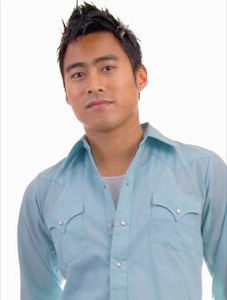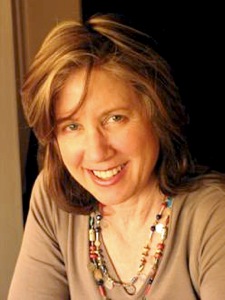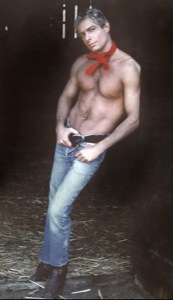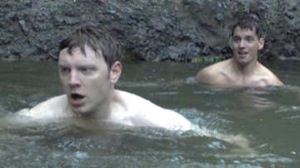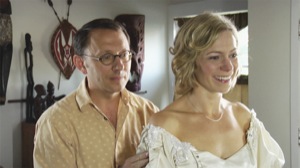Arts & Entertainment
L.A.’s Outfest represents
Published Thursday, 03-Jul-2008 in issue 1071
Since 1982, the Los Angeles Gay & Lesbian Film Festival – Outfest – has continued to further its mission statement which “protects our past, showcases our present and nurtures our future by fostering artistic expression of gender, sexuality and LGBTQ culture and its transformative social impact on the world.”
Each year, the non-profit organization presents films that represent a broad array of GLBT lifestyles.
This year is no exception, with 212 films from more than 25 countries being screened for the 26th annual festival, showcasing stories in documentary and full-length form.
In addition to the multitude of films being shown in eight different venues throughout Los Angeles during the festival’s July 9-21 run, there are also parties and events to attend, and more than a dozen panels scheduled.
The Gay & Lesbian Times spoke with a number of those involved with the film festival, including filmmakers, actors, award recipients and documentary subjects, who are exploring all walks of GLBT life through the magic of the movies.
Putting the ‘T’ in documentary
At first glance Trinidad, Colo., population 9,000, seems like any other rural town. But, as the documentary Trinidad reveals, this sleepy settlement has become known as “the sex-change capital of the world.” The leap from a Wild West colony and once mafia-ruled coal mining township to a place where upwards of 6,500 transsexuals have sought out the services of Dr. Stanley Biber since 1969 is explored through the story of three transgender women.
Dr. Marci Bowers is the first transgender surgeon to perform Gender Reassignment Surgeries and took over Biber’s practice; Sabrina Marcus, one of Bowers’ patients is the founder of the Southern Comfort Transgender Conference; and Dr. Laura Ellis is a family practitioner who is fully transitioning into life as a female.
The three set out to renovate a Victorian house to transform it into a post-op recovery bed-and-breakfast, and the documentary details each woman’s history and day-to-day lives, without sensationalizing the aspects of their transformations.
This element of the documentary was paramount for one of Trinidad’s directors, P.J. Raval, who wanted to paint a more humane portrait of the everyday lives these women lead.
“It was very important to humanize these individuals,” he said. “Because I think the transgender community is just completely underrepresented in all medias. And the stories we do get are very sensationalized, and they very much focus on the physical surgery aspects – we live in a culture that is very obsessed with transformation and body modification. So, naturally all of the interest when transgender comes up is going to be on the physical appearance aspects.”
The town’s claim to fame was brought to Raval’s attention at a dinner party, when a female guest told stories about “how it was rumored there were transsexuals and cowboys roaming the streets,” he said.
“I just couldn’t imagine that I was so unaware of this town’s existence, and what was happening there,” Raval said. “So, sure enough we Internet searched it a couple of days later and found out about Dr. Biber’s history; and the practice that had been going on since the ’60s, which also blew our minds.”
In 2004, Biber (who has since passed away) was handing over his practice to Bowers. Raval placed a call to Bowers, whom he termed as “really warm and inviting” on the phone and took his first trip to Trinidad. The journey became the first production trip for the documentary.
The town itself proved to be an integral part of the storytelling process, Raval said.
“Part of what’s happening there, you have to give the town credit, because the stereotype of small town America would be that, any small town would be running transsexuals out of town – they would not be accepted,” Raval said. “It was really a little bit of a mystery of what was going on in this town: Were people just being polite, or if they were really accepting of this. We went around and got different perspectives from local business owners, we interviewed kids to get their take on gender. We definitely got some interesting responses.”
Raval hopes audiences will respond to Trinidad and adopt the town’s approach of valuing individuals, not what they see at face value.
“I was very touched and moved by meeting these women and hearing their stories,” Raval said. “And, it was really important to me to make sure that they as people, as individuals, as humans, just as everyone else – their stories get told. And, in the process, hopefully the audience will recognize that, sure, there are definitely some differences between themselves and the transsexual women they are seeing on screen; but, that they actually have a lot of similarities.”
Iconic status
Another film auteur who has taken a similar approach in illustrating similarities in her cinematic work is iconic lesbian director, Donna Deitch, the recipient of Outfest’s Career Achievement Award.
“I’m extremely honored,” Deitch said of the accolade. “In part, because I have such a high regard for Outfest, and what they have been doing all of these years in promoting gay and lesbian culture via film.”
In 1985, Deitch directed the seminal lesbian film, Desert Hearts, during a time when there wasn’t a windfall of films geared towards the Sapphic audience, in particular that dealt with the subject matter in a positive manner; Deitch was also the first lesbian director to helm a lesbian-themed film.
Desert Hearts, which is set during the late ’50s, is the story of Vivian Bell (Helen Shaver) and Kay Riwers (Patricia Charbonneau), who find an oasis of love set against the backdrop of the Nevada desert, where Shaver’s character must live for six weeks in order to finalize her divorce.
The film has been heralded as groundbreaking, and has achieved a cult-like status with a very devoted fan base, which is still strong some 23 years later.
“That’s one of those magical occurrences,” Deitch said of the film’s wide-reaching appeal and longevity. “It’s just hard to really know what’s going on out there. I attribute it to some sort of magic, I guess I would say. There’s something there that connected and continues to connect.”
In fact, last year saw a special edition of Desert Hearts was released with a number of extras, including all participants describing what it was like to be a part of this special movie. On the heels of the special release, there is a documentary in the works, Desert Hearts Mon Amour, on the film’s staying power, but Deitch is on the opposite side of the camera this time around.
Deitch also gave us the scoop on a sequel to Desert Hearts.
“I’m writing a sequel right now, not a conventional sequel – but nonetheless, a sequel,” the director said. “It takes place during the second wave of the Women’s Liberation Movement in New York City. It doesn’t specifically follow the original characters, although they are in it; it then begins to include more and more characters. I’m beginning to see Desert Hearts as a franchise; then it could on into another decade and another decade, and on from there.”
The film may see the staying power of Jack Wrangler, who, in the ’70s was arguably the biggest gay porn star in the world. Wrangler, whose given name is John Robert Stillman, is the subject of the documentary, Wrangler: Anatomy of an Icon, which explores his intriguing life.
During his life, Wrangler was a child star on the religious-themed family show, “Faith of Our Children,” at the age of nine. During his college years, he was a model and dancer, and after he appeared in a male strip show, and starred in gay porn films such as Kansas City Trucking Co. He also switched over to straight porn during his adult film work tenure, which garnered him an even greater cult status.
Having the title “icon” attributed to his legacy, and the documentary on his life has special meaning for the star.
“When that word first came out, and I heard that was the working title, I said to the producer that would be the first word that goes,” he answered with a chuckle. “They kept the word icon, and no one was more surprised than me.”
Wrangler is also humble about his fame as one of the most memorable performers in gay porn history.
“Well, I think that’s for someone else to decide,” Wrangler said. “I’m glad they’re taking another look at the ’70s, because it was a strange and weird, rather rarified time. We had this great innocence of people trying to find themselves, who they were, and their own sexuality, their own personal identification.”
In fact, in 1976, Wrangler met 1940s singer Margaret Whiting when he was 33 and she was 55. And despite the fact he told her of his homosexuality, she responded that he was gay “only around the edges, dear,” and the two formed a relationship and have been married since 1979. He feels the longevity of his marriage is based on the pair’s common ground.
“I fell in love with her the night I met her,” Wrangler said. “I’ve always wanted to make sure that people understood that does not make me bisexual or straight – I’m a gay man. It’s just that being gay is so difficult, it’s very competitive. I would have been a lousy, lousy gay lover, and I knew it.”
Coinciding with his marriage to Whiting, Wrangler retired from the porn industry and began writing and producing cabaret and musical theater, an area of interest for Wrangler prior to his film career.
But having his life on display with Wrangler: Anatomy of an Icon is not uncommon for Wrangler, who published the memoir “The Jack Wrangler Story: Or What’s A Nice Boy Like You Doing?” in the ’80s.
“I never thought in terms of actually going further than writing the book,” he said. “I felt like if there was anything I had to say, I’d like to say it from my angle. And director Jeffrey Schwarz made me such an interesting presentation, saying, ‘I’d like to do it your way and talk about things you like to talk about.’ And, we’ve been working on it for eight years!”
In a sense, Wrangler handed over his life to Schwarz, giving him carte blanche to old posters, pictures and reviews, which he said felt like a “wonderful cleansing.”
“So, he waded through all of that material and this was the film he came up with,” Wrangler said of the creative process. “Our deal was that I did not want to know anything about the film, or what it was going to entail until it was completed. Because I felt it should be his statement and not mine, it’s really about Jeffrey Schwarz and not Jack Wrangler – it’s about a filmmaker. It was a wonderful honor, and I’m so grateful that he did it.”
Bi Coast al
Speaking of filmmakers making a statement, Gabriel Fleming, director of the beautifully filmed and hauntingly ethereal movie, The Lost Coast, seems to be saying to the film going populace, “Look at me, and what I can do” in a very auspicious way.
The Lost Coast centers on Jasper, Mark and Lily (played by Ian Scott McGregor, Lucas Alifano and Lindsay Benner), a trio of 20-somethings, who have been friends since high school, and reunite on Halloween night in The Castro.
During this evening, ghosts from the past threaten their present; specifically regarding events that transpired during a long ago camping trip to the titular Lost Coast, where Jasper and Mark engaged in a sexual liaison, one which Mark has never forgotten and which Jasper has emotionally distanced himself from.
The inspiration for the fictional film came from a very real place for Fleming.
“I occupy a gray area of sexuality,” Fleming said. “So I really wanted to make a movie that showed the internal struggle of coming to terms with your sexuality, when you don’t fit into the dominant gay/straight dichotomy.”
Setting the film on All Hallows Eve seems a fitting analogy for the characters in the film, as the past comes back to haunt them.
Fleming, who also penned the screenplay, was drawn to use Oct. 31 as a backdrop because “it has that otherworldly feel that I’m interested in. Halloween is the one time where everyone gets together and transcends their normal lives. So, it was an obvious choice to put this story of transcending your ideas of your own sexuality.”
Filming on Halloween in a hugely populated area did provide him with certain challenges.
“It was difficult just to be doing something as difficult as filming in general among so many people, and among so much noise and hectic-ness,” he said. “There wasn’t anything tough about dealing with police, or no one really interfered with us, except people who would look into the camera and go, ‘Woo!’ But that wasn’t really a problem; I think it was more the psychological aspect of trying to get a dialogue scene done in such a frenetic environment.”
The Lost Coast is Fleming’s second foray into both writing and directing a film (the first was 2002’s One Thousand Years). For the writer/director, choosing one storytelling medium over the other would prove a tricky choice.
“The scripts that I write, they’re never meant to be done by somebody else, at least for these films,” he said. “And in a way, they are incomplete – they are hard to show to people, because in script form they don’t express the whole that I’m thinking of with the movie.
“For example, the tone of The Lost Coast, which I think is such an important part of it, doesn’t really come through in the script,” he said. “So, it’s hard for me to separate the two.”
A family affair
The same could be said of Michael Emerson (Benjamin Linus of TV’s “Lost”) and Carrie Preston (Felicity Huffman’s sister in Transamerica), the husband and wife acting duo starring in Ready? OK! who were happy to be able to work on a project together.
“It was an amazingly easy thing for me to get out the emotion, because I was looking in to the eyes of my husband,” Preston said of her spouse of nearly a decade. “We didn’t require any rehearsal, really, because we have so much history together.”
“I was able to be easy and confident about it, knowing that the other part was being played by a veteran player, like Carrie,” Emerson added. “That I could trust her to just plain take care of business, and be in the scene moment-to-moment. Also, I’m familiar with the range of emotional signals that she’s capable of, both as a person and as a performer.”
The film, which features a plotline revolving around a mother (Preston) coming to terms with her son being fixated with cheerleading, dolls and dresses, was lensed in San Diego by writer/director James Vasquez, and is described as a “poignant comedy.”
“I always find that, actually, what makes a good comedy performance is when you do find the pathos in it, and vice-versa,” Preston said of the balancing act of comedy laced with drama.
Ready? OK! also does something very different for a coming-of-age type movie; it is told from the mother’s point-of-view about having a son exhibiting potentially gay behavior. Preston reported that Vasquez made the film as “a love letter to honor the parents, because they have a coming out process, as well.”
This approach, not often seen on the screen, was a very important aspect for both actors, because it opens up areas of discussion.
“One of the friends of the parents of the little boy in the movie, he and his wife are from South Carolina, and they came up to me said, ‘I need people to see this movie, I needed to see this movie, because I’m just a big ol’ lunkhead!’” Preston said. “And I don’t think I got it until now, he said, ‘My son is really artistic, and I don’t want to mess him up.’ He said that to me, and I was like, ‘Oh my God.’”
“I really like their (the film production company) mission,” Emerson said. “I like the light touch that they bring to it. And, I also like to see the different ways that it provokes response in other people.”
Both Preston and Emerson have very gay-friendly resumes. Preston has played Felicity Huffman’s sister two-fold, once in the aforementioned Transamerica, and also on “Desperate Housewives,” and she has also appeared on “Sex and the City.” Her favorite gay themed project was the 2004 film Straight-Jacket.
Emerson also had a part in that movie as a gay butler, and portrayed Oscar Wilde on stage, but Ready?OK! constitutes his first gay starring film role as Charlie New, neighbor of Preston’s character Andy Dowd.
“Charlie was beautifully written on the page,” Emerson said. “And I think we all know someone in our lives that is a Charlie; someone who has fought their battles, already suffered their wounds, and found a philosophical and serene place from which to watch the world.”
As for his small screen alter ego, the villainously complicated Ben on “Lost,” Emerson finds that the public-at-large is able to separate him from his role – to a degree.
“In the front part of their brains, I think everybody understands we’re actors and we’re pretending to be something,” he explained. “But, on some subliminal level, I think people have a harder time disassociating the performer from the character. So, even though people are very friendly when they meet me, I can tell there is a guardedness – they have a tendency to keep their distance.”
And, in a twist that only “Lost” could provide, Preston was cast as Emerson’s mother in one episode.
“It was my sick idea, actually,” Preston confessed. “I’ve been a huge fan of ‘Lost’ from the original airing of the pilot. So when Michael got on the show, I really wanted to do a guest spot, and then one day it hit me: ‘What would be the most twisted thing that would fit into the whole ‘Lost’ mythology? Oh, I’ll play his mother in a flashback!’”
Oedipal complexes aside, for Emerson and Preston making Ready? OK! has been a veritable family affair; not only are the spouses starring opposite each other, Preston’s real-life brother, John G. Preston, plays her brother on camera, as well.
“We’re a very queer-cinema friendly household,” Preston said, perfectly summarizing the mission statement of Outfest, with its wide variety of films offering something for everyone.
For a schedule of events, panels, film times and locations, visit http://www.outfest.org/fest2008/index.html
|
|
Copyright © 2003-2025 Uptown Publications

